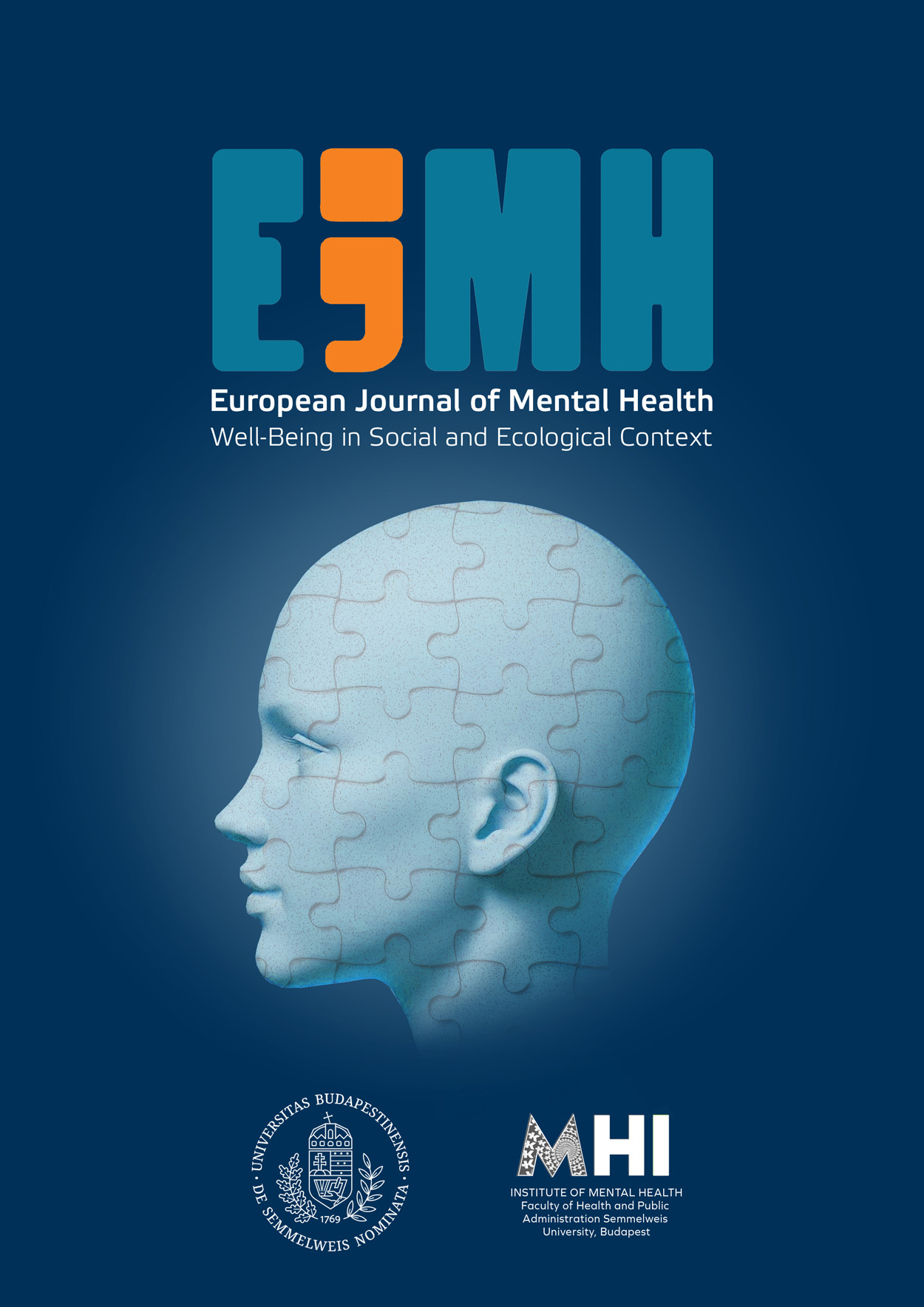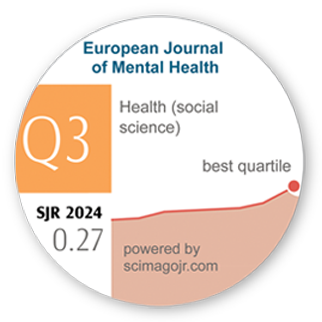Why Do Adolescents Use Social Media? Validation of the Croatian version of Motives to Use Social Networking Sites Scale
DOI:
https://doi.org/10.5708/EJMH.20.2025.0046Keywords:
social media, motivation, adolescents, MOTUS scale, fear of missing outAbstract
Introduction: Motivation for social media use is a multidimensional construct; however, most existing questionnaires focus solely on motives and do not distinguish between active and passive use. To address this, the Motives to Use Social Networking Sites Scale (MOTUS; Reimann et al., 2023) was developed, integrating motivational aspects and usage modes.
Aim: This study examined the construct and convergent validity of the MOTUS scale in Croatian high school students. The original eight-factor model was tested with confirmatory factor analysis (CFA), and measurement invariance across gender was assessed with multigroup CFA. Associations with social media, loneliness, and fear of missing out were analysed for convergent validity. The Average Variance Extracted (AVE) and the Heterotrait– Monotrait (HTMT) ratio were also calculated to further evaluate the MOTUS scale. Reliability was assessed with Cronbach’s α and Macdonald’s ω.
Methods: Participants were 853 adolescents aged 14–19 (M = 16.21, SD = 1.07; 69.6% women). In addition to MOTUS, they completed the Fear of Missing Out Scale (FoMO), De Jong Gierveld Loneliness Scale and estimated daily time on social media.
Results: The eight-factor model showed acceptable fit after removing one item with cross-loadings (CFI = .916, TLI = .900, RMSEA = .061, SRMR = .074). Measurement invariance supported configural, metric, and scalar equivalence across gender. Convergent validity was confirmed through significant correlations between MOTUS subscales, time on social media, and FoMO.
Conclusions: The MOTUS scale shows acceptable psychometric properties for assessing motives and usage modes of social media in Croatian adolescents.
References
Anderson, M., & Jiang, J. (2018). Teens, social media & technology 2018. Pew Research Center.
https://www.pewresearch.org/internet/2018/05/31/teens-social-media-technology-2018/
Barry, C. M., Madsen, S. D., Nelson, L. J., Carroll, J. S., & Badger, S. (2009). Friendship and romantic relationship qualities in emerging adulthood: Differential associations with identity development and achieved adulthood criteria. Journal of Adult Development, 16, 209–222.
https://doi.org/10.1007/s10804-009-9067-x
Best, P., Manktelow, R., & Taylor, B. (2014). Online communication, social media and adolescent wellbeing: A systematic narrative review. Children and Youth Services Review, 41, 27–36.
https://doi.org/10.1016/j.childyouth.2014.03.001
Buecker, S., Mund, M., Chwastek, S., Sostmann, M., & Luhmann, M. (2021). Is loneliness in emerging adults increasing over time? A preregistered cross-temporal meta-analysis and systematic review. Psychological Bulletin, 147(8), 787–805.
https://doi.org/10.1037/bul0000332
Chen, F. F. (2007). Sensitivity of goodness of fit indexes to lack of measurement invariance. Structural Equation Modeling, 14(3), 464–504.
https://doi.org/10.1080/10705510701301834
Cheung, G. W., & Rensvold, R. B. (2002). Evaluating goodness-of-fit indexes for testing measurement invariance. Structural Equation Modeling: A Multidisciplinary Journal, 9(2), 233–255.
https://doi.org/10.1207/S15328007SEM0902_5
Choi, D.-H. (2024). Impact of social media use on the life satisfaction of adolescents in South Korea through social support and social capital. SAGE Open, 14(2), 1–12.
https://doi.org/10.1177/21582440241245010
De Jong-Gierveld, J., & Kamphuis, F. (1985). The development of a Rasch-type loneliness scale. Applied Psychological Measurement, 9(3), 289–299.
https://psycnet.apa.org/doi/10.1177/014662168500900307
De Jong-Gierveld, J., & van Tilburg, T. G. (1999). Manual of the Loneliness Scale. Methoden en technieken.
https://doi.org/10.17605/osf.io/u6gck
DeVellis, R. F. (2003). Scale development: Theory and application. Sage.
Ellison, N. B., Vitak, J., Gray, R., & Lampe, C. (2014). Cultivating social resources on social network sites: Facebook relationship maintenance behaviors and their role in social capital processes. Journal of Computer-Mediated Communication, 19(4), 855–870.
https://doi.org/10.1111/jcc4.12078
Faverio, M., & Sidoti, O. (2024). Teens, social media and technology 2024. Pew Research Center.
https://www.pewresearch.org/wp-content/uploads/sites/20/2024/12/PI_2024.12.12_Teens-Social-Media-Tech_REPORT.pdf
Hair, J. F., Sarstedt, M., Pieper, T. M., & Ringle, C. M. (2012). The use of Partial Least Squares Structural Equation Modeling in strategic management research: A review of past practices and recommendations for future applications. Long Range Planning, 45(5–6), 320–340.
https://doi.org/10.1016/j.lrp.2012.09.008
Henseler, J., Ringle, C. M., & Sarstedt, M. (2015). A new criterion for assessing discriminant validity in variance-based structural equation modeling. Journal of the Academy of Marketing Science, 43(1), 115–135.
https://doi.org/10.1007/s11747-014-0403-8
Hooper, D., Coughlan, J., & Mullen, M. R. (2008). Structural Equation Modelling: Guidelines for determining model fit. The Electronic Journal of Business Research Methods, 6(1), 53–60.
https://academic-publishing.org/index.php/ejbrm/article/view/1224
Jarman, H. K., Marques, M. D., McLean, S. A., Slater, A., & Paxton, S. J. (2021). Motivations for social media use: Associations with social media engagement and body satisfaction and well-being among adolescents. Journal of Youth and Adolescence, 50(12), 2279–2293.
https://doi.org/10.1007/s10964-020-01390-z
Jong, S., & Drummond, M. (2016). Hurry up and ’like’ me: Girls, social media and immediate feedback. Asia-Pacific Journal of Health, Sport and Physical Education, 7, 251–267.
https://doi.org/10.1080/18377122.2016.1222647
Katz, E., Blumler, J. G., & Gurevitch, M. (1973). Uses and gratifications research. Public Opinion Quarterly, 37(4), 509–523.
https://doi.org/10.1086/268109
Keles, B., McCrae, N., & Grealish, A. (2020). A systematic review: the influence of social media on depression, anxiety and psychological distress in adolescents. International Journal of Adolescence and Youth, 25(1), 79–93.
https://doi.org/10.1080/02673843.2019.1590851
Kline, R. B. (2005). Principles and practice of structural equation modeling (2nd ed.). Guilford Press.
Kim, Y., Sohn, D., & Choi, S. M. (2011). Cultural difference in motivations for using social network sites: A comparative study of American and Korean college students. Computers in Human Behavior, 27(1), 365–372.
https://doi.org/10.1016/j.chb.2010.08.015
Kovač, S. (2024). Povezanost straha od propuštanja, usamljenosti te problematičnog korištenja interneta i učestalosti korištenja društvenih mreža [The relationship between fear of missing out, loneliness, problematic internet use, and frequency of social media use]. “Unpublished master thesis” Faculty of Humanities and Social Sciences, University of Rijeka.
https://repository.ffri.uniri.hr/islandora/object/ffri:4646
Lee, E., Lee, J.-A., Moon, J. H., & Sung, Y. (2015). Pictures speak louder than words: Motivations for using Instagram. Cyberpsychology, Behavior, and Social Networking, 18(9), 552–556.
https://doi.org/10.1089/cyber.2015.0157
Leung, L. (2013). Generational differences in content generation in social media: The roles of the gratifications sought and of narcissism. Computers in Human Behavior, 29(3), 997–1006.
https://doi.org/10.1016/j.chb.2012.12.028
Little, T. D. (2013). Longitudinal structural equation modeling. The Guilford Press.
Mahalingham, T., McEvoy, P. M., & Clarke, P. J. (2023). Assessing the validity of self-report social media use: Evidence of No relationship with objective smartphone use. Computers in Human Behavior, 140, Article 107567.
https://doi.org/10.1016/j.chb.2022.107567
Masciantonio, A., & Bourguignon, D. (2023). Motivation Scale for Using Social Network Sites: Comparative study between Facebook, Instagram, Twitter, Snapchat and LinkedIn. Psychologica Belgica, 63(1), 30–43.
https://doi.org/10.5334/pb.1161
Midgley, C., Thai, S., Lockwood, P., Kovacheff, C., & Page-Gould, E. (2021). When every day is a high school reunion: Social media comparisons and self-esteem. Journal of Personality and Social Psychology, 121(2), 285–307.
https://doi.org/10.1037/pspi0000336
Omar, B., & Dequan, W. (2020). Watch, share or create: The influence of personality traits and user motivation on TikTok mobile video usage. International Journal of Interactive Mobile Technologies, 14(4), 121–137.
https://doi.org/10.3991/ijim.v14i04.12429
Orchard, L. J., Fullwood, C., Galbraith, N., & Morris, N. (2014). Individual differences as predictors of social networking. Journal of Computer-Mediated Communication, 19(3), 388–402.
https://doi.org/10.1111/jcc4.12068
Przybylski, A. K., Murayama, K., DeHaan, C. R., & Gladwell, V. (2013). Motivational, emotional, and behavioral correlates of fear of missing out. Computers in Human Behavior, 29(4), 1841–1848.
https://doi.org/10.1016/j.chb.2013.02.014
Reimann, L.-E., Ozimek, P., Rohmann, E., & Bierhoff, H.-W. (2023). Validation of the Motives to Use Social Networking Sites Scale (MOTUS). Telematics and Informatics Reports, 11, Article100080.
https://doi.org/10.1016/j.teler.2023.100080
Rothwell, J. (2023). Parenting mitigates social media-linked mental health issues. Gallup.
https://news.gallup.com/poll/513248/parenting-mitigates-social-media-linked-mental-health-issues.aspx.
Satorra, A., & Bentler, P. M. (1994). Corrections to test statistics and standard errors in covariance structure analysis. In A. von Eye & C. C. Clogg (Eds.), Latent variables analysis: Applications for developmental research (pp. 399–419). Sage Publications, Inc.
Smith, D., Leonis, T., & Anandavalli, S. (2021). Belonging and loneliness in cyberspace: Impacts of social media on adolescents’ well-being. Australian Journal of Psychology, 73(1), 12–23.
https://doi.org/10.1080/00049530.2021.1898914
Tabachnick, B. G., & Fidell, L. S. (2007). Using multivariate statistics (5th ed.). Pearson Education.
Teppers, E., Luyckx, K., Klimstra, T. A., & Goossens, L. (2014). Loneliness and Facebook motives in adolescence: A longitudinal inquiry into directionality of effect. Journal of Adolescence, 37(5), 691–699.
https://doi.org/10.1016/j.adolescence.2013.11.003
Twenge, J. M., & Campbell, W. K. (2019). Media use is linked to lower psychological well-being: Evidence from three datasets. Psychiatric Quarterly, 90(2), 311–331.
https://doi.org/10.1007/s11126-019-09630-7
Uhls, Y. T., Ellison, N. B., & Subrahmanyam, K. (2017). Benefits and costs of social media in adolescence. Pediatrics, 140(Supplement 2), S67–S70.
https://doi.org/10.1542/peds.2016-1758E
Valkenburg, P. M., & Piotrowski, J. T. (2017). Plugged in: How media attract and affect youth. Yale University Press.
Verduyn, P., Ybarra, O., Résibois, M., Jonides, J., & Kross, E. (2017). Do social network sites enhance or undermine subjective well-being? A critical review. Social Issues and Policy Review, 11(1), 274–302.
https://doi.org/10.1111/sipr.12033
Vogel, E. A., Rose, J. P., Roberts, L. R., & Eckles, K. (2014). Social comparison, social media, and self-esteem. Psychology of Popular Media Culture, 3(4), 206–222.
https://psycnet.apa.org/doi/10.1037/ppm0000047
Wheaton, B., Muthen, B., Alwin, D. F., & Summers, G. F. (1977). Assessing reliability and stability in panel models. In D. R. Heise (Ed.), Sociological Methodology (pp. 84–136). Jossey-Bass.
Winstone, L., Mars, B., Haworth, C. M. A., & Kidger, J. (2021). Social media use and social connectedness among adolescents in the United Kingdom: a qualitative exploration of displacement and stimulation. BMC Public Health, 21, Article 1736.
https://doi.org/10.1186/s12889-021-11802-9
Yang, C-c., Holden, S. M., & Carter, M. D. K. (2018). Social media social comparison of ability (but not opinion) predicts lower identity clarity: Identity processing style as a mediator. Journal of Youth and Adolescence, 47, 2114–2128.
https://doi.org/10.1007/s10964-017-0801-6






